Kategorie: ‘United States of America’
Research stay at Georgia Institute of Technology
- Aerospace Engineering M.Sc.
- USA, Atlanta
- Georgia Institute of Technology, Aerospace System Design Laboratory (ASDL)
- 05/2023 – 09/2023
Application and Preparation
There has been a long-standing relationship between the Institute of Aerospace Systems (ILR) and the renowned Aerospace System Design Laboratory (ASDL) in Atlanta. Due to my activities as a bachelor student and as a student assistant for many years at ILR, I was given the unique opportunity to spend a research period at ASDL and to work there. The cooperation exists between the professors at both institutes.
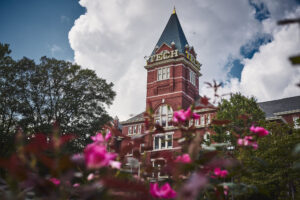
Tech Tower of Georgia Institute of Technology
© Johannes Götz
In November 2022, I started planning and approached ILR about my desire to go there. Due to the choice of my area of work – the ASDL has six great research branches – the visa issuance and the related working documents took a few months. In May 2023, I could already start working remotely and got to know the team. From July until the end of September, I was on site at the Laboratory and worked there as a research assistant. Since I worked in a project belonging to the Defense & Space division, I had to wait some time for my DS-2019 (important work permit).
Accommodation and Living Situation in Atlanta
Finding housing in Atlanta is proving to be difficult. You must be careful at what time you are there because the semester times are very different from ours. In the summer, it is relatively easy to get an apartment for subletting. Facebook groups are excellent for this purpose. However, as always with such portals you must be warned of potential scammers. I first moved into a shared apartment and later into an Airbnb because the semester starts again at the end of August and the apartment search is extremely difficult then. The rental costs are at least about 1500$ per month. Georgia Tech supports you with the purchase of a monthly ticket for the local bus and train transport, called MARTA.
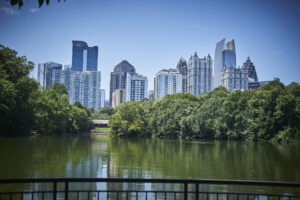
View of Atlanta Midtown from Piedmont Park
© Johannes Götz
These cost $66 per month and the network is well developed by American standards. From time to time, buses and trains are cancelled, but with the appropriate apps and enough scheduled time, I had no problems moving freely in Atlanta and the surrounding area. At night, however, you just must watch out and always be aware of your surroundings. Atlanta can be dangerous at night but also very beautiful. Common sense is highly recommended here and in case of emergency, you should always use services like Uber or Lyft. On Georgia Tech’s campus, there are several bus lines that make regular stops during the week, so it’s easy to get anywhere. I don’t recommend biking because of the traffic and the heat in the summer, though of course it depends on how far away you live.
The Work
I was working in the Defense & Space division on a project that dealt with the active removal of space debris and developed corresponding systems. My activities included work with complex FEM software, simulation of spacecraft control and simulation of the satellite systems and practical tests on tensile testing machines as well as larger test environments for validation and verification of the performed simulation work. It was a joint project between different laboratories and research institutes. NASA engineers were consolidating every couple of weeks. Various other institutions were involved in the project besides the
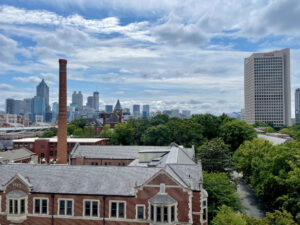
View over south campus from Georgia Tech’s library. Left side view is Downtown, right side is the Coca-Cola headquarter.
© Johannes Götz
Aerospace System Design Laboratory. The most important were Georgia Tech Research Institute, Space System Design Laboratory, various NASA labs, and Georgia Tech’s College of Design. Because of this diversity of partners, meetings were always necessary to keep each other up to date. I worked together with 8 other Graduate Research Assistants. In parallel to my work, I was still working on the DLR Design Challenge remotely. My working hours were 9am-5pm and I spent every day at the institute but was also able to work from home at times. The project does not fall under US export control yet, which made it possible to work in this sector as a foreigner. So, it was a unique opportunity to get to know US work in the space sector.
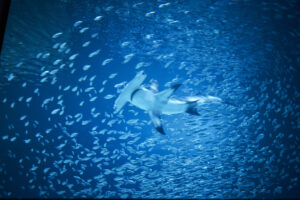
Georgia Aquarium is one of the largest aquariums in the world. A must-see!
© Johannes Götz
Free Time and Tips for Atlanta
Atlanta offers a wide range of activities, all of which are accessible by bus and train. Besides the famous attractions like the Georgia Aquarium, Hall of Fame College Football, the World of Coca-Cola and the huge Mercedes-Benz Stadium, there are also beautiful parks. Take a walk through the Botanical Garden or visit the photo spot in Piedmont Park overlooking the Midtown skyline. Many series and movies have been filmed in and around Atlanta, including Stranger Things and The Walking Dead. Some movie locations exist in reality and can be visited. A trip to Hawkings Lab from the series Stranger Things, for example, was very memorable. At the Mall of Georgia, movies are shown in real (!) IMAX format. A trip there to see Christopher Nolan’s Oppenheimer was very worthwhile. A trip to Buckhead to visit the design and art museums and see the town there is also ideal for spending free time. For American football, field hockey or – the Americans call it soccer – football fans, there is a wide range of things to do, and watching an authentic football game at Mercedes-Benz Stadium was an unforgettable experience. For connoisseurs and lovers of the famous Rocky Horror Picture Show I can only recommend to experience it with authentic disguises and get a quasi-4D cinema show.
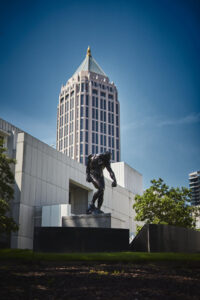
High Museum of Art in north Midtown
© Johannes Götz
The food scene in Atlanta is diverse and a culinary feast for the eyes. Excellent fried chicken, barbecue and coffee shops make you forget the hot summer temperatures there. Rooftop pool parties and cooking together as well as barbecuing together were also part of the everyday unwinding after work.
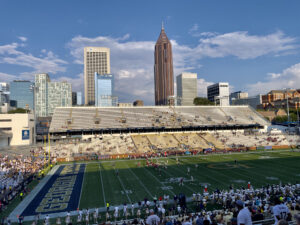
Typical college football game at GT’s home stadium. Go Yellow Jackets!
© Johannes Götz
Conclusion
My research stay in Atlanta was a great enrichment for me personally and an optimal opportunity to apply what I had learned at RWTH and to actively participate in a professional work environment. In addition to the linguistic education, I was able to learn a lot of positive things about American culture. There, a healthy competitive spirit, and a positive attitude towards passionate ambition prevail. These attributes are much more practiced in the U.S. than I thought. The idea of a life’s dream or achieving a good life’s goal is strong there. The students see themselves together in a team, and they also encourage each other to overcome difficult phases in life. I will carry this optimistic and motivating attitude forward. It is a great opportunity for a RWTH student to be able to do such research stays and to represent RWTH and Germany abroad.
Research Internship in Santa Barbara
- Chemistry M.Sc.
- United States of America, Santa Barbara
- University of California, Santa Barbara (UCSB)
- 05/2023 – 09/2023
- Application/Finding an internship
Studying Chemistry M.Sc. at RWTH Aachen University comes with three mandatory research internships which optionally can be completed at an external institution. Inspired by a talk at a conference I contacted the professor via e-mail asking for a research stay about nine months in advance. After her approval the administrative process including some visa guidance was handled by the Department of Chemical Engineering and the Office of International Students and Scholars (OISS) at the University of California, Santa Barbara (UCSB).
Applying early, I got the visa about four months in advance. The OISS at UCSB is an approved J1-sponsor. Several documents were required by the Department of Chemical Engineering and/or the OISS. I needed proof of health insurance, financial proof and a language certificate among others. The DS-2019 was issued by OISS at UCSB and is required for the visa application. Additionally, a SEVIS fee is required prior to the visa interview. In my case, the interview waiver applied which allowed me to send in my passport to the
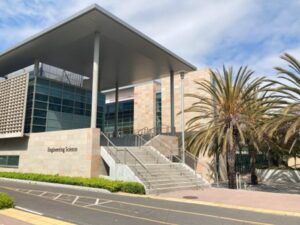
Engineering Science Building
© Elisabeth Richter
consulate in Frankfurt and have it sent back to me once the visa was approved.
Applying early, I had plenty of time between the approved visa and my starting date so I could book my flight and look for an accommodation several weeks in advance. Since I was a visiting grad student not taking any classes I was not enrolled as a UCSB student and did not have to pay any tuition fees but also did not get the student benefits.
- Accommodation & Living expenses
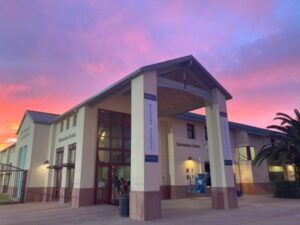
Recreation Center
© Elisabeth Richter
Housing options are either student housing on and off campus or private housing in Isla Vista, Goleta area or Downtown Santa Barbara. The latter requires a daily commute by bus or car to the campus whereas the other options are within walking or biking distance.
As a visiting grad scholar, I was not eligible for student housing. I found a nice host parents arrangement living with up to two other students via a private housing listing provided by UCSB. Leasing or Subleasing is usually tied to the quarter system. In general, be aware of scams. Compared to Aachen, living expenses are higher in America and particularly high in the Santa Barbara area. For a single room about $1300 per month are common whereas doubles or triples are usually a little cheaper. Compared to Aachen, my expenses for groceries went up 1.5 to 2 times. Even though going out is much more common I had a lot of self-cooked meals. In general, fruits and vegetables are more expensive. For fresh, organic fruits and vegetables I recommend the farmers market which serves the best sourdough bread I had during my stay.
- Everyday life/the internship

Campus Point Beach
© Elisabeth Richter
Biking is the way to go around on the UCSB campus. The best chances to not get one’s bike stolen is in having a cheap bike and a U-lock. Used bikes can be purchased in a bike shop in Isla Vista or online. Outside of campus busses as public transportation are an option but depending on where to go cars might be the only choice.
Major food options on campus are in the UCen building serving sandwiches, burgers, and American Chinese food among others. In addition, there are cafes distributed throughout the campus selling mostly sandwiches and snacks.
The research group I visited provided lab space as well as a desk in the offices. Working with several colleges on a project I was fully integrated in the group during my stay. On average, I had biweekly meetings with my professor at UCSB discussing my research progress and giving valuable input. I attended the weekly group meeting taking turns in presenting one’s research progress and recent literature.
I usually worked in the lab on weekdays and used the evenings and weekends to explore the area. The recreation center offers intermural, fitness and dancing classes among others. The campus is right next to the ocean and always worth a visit. Part of the campus is the Campus Point which beach area is suitable for beginners in surfing.
One thing to keep in mind is that I stayed at UCSB during the summer which is way quieter than throughout the rest of the year. Same goes for the research group because of the lack of lectures but professors might not be available each week due to travelling to conferences or summer schools.
- Free time/tips
The campus itself is beautiful and a walk around the campus lagoon is a must. You can get a great view of the campus from the upper floor of the Davidson’s library both towards the mountains and the ocean. I highly recommend spending time at the ocean and watching a lot of sunsets. The surf class by the USCB recreation center is a lot of fun. They provide surfboards and wetsuits during the lessons and there is also a rental option at Campus Point Beach.
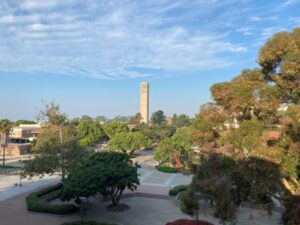
Campus and Storke Tower
© Elisabeth Richter
Going out there are some bars and breweries in the Goleta area to check out (beers can be purchased starting from about $7; remember the legal drinking age of 21) and even more options in Downtown Santa Barbara. The bus ride to Downtown takes 35 to 55 minutes. Alternatively, there is a 10-mile bike path connecting UCSB and Downtown Santa Barbara. Main attractions are the Santa Barbara Mission, the botanical garden, a walk on State Street and the waterfront. Ferries are connecting Santa Barbara to the Channel Islands National Park which is a great destination for hiking and camping. Whale Watching tours starting in Santa Barbara might go all the way to the Channel Islands seeing dolphins and humpback whales along the trip.
Both Goleta and Santa Barbara are connected to the Pacific Surfliner which goes from San Luis Obispo all the way south to San Diego. The train track itself is right next to the ocean giving this slow way of traveling an amazing view throughout the ride.
- Conclusion
My research stay at UCSB was a fascinating journey. I broadened my knowledge in Chemistry and gained a lot of new experiences on the personal level as well. Even though it took me some time to get used to the different culture I enjoyed the way of life. Within time, communicating in everyday English became natural and I understand and highly acknowledge the American humor by now. I met great people along the way to which I will catch up eventually. I highly encourage a stay abroad.
Research visit at Cornell University
- Mechanical Engineering, PhD
- USA, Ithaca
- Cornell University
- 03/2023 – 05/2023
- Application/Finding an internship
Since the start of my Ph.D., I planned to do a research visit abroad, and I was constantly looking for research questions that were suitable for it. Even though my ideas did not really convince me, I scheduled a meeting with my Ph.D. advisor. In this meeting, we discussed possible research groups which fit my research topics. Based on this, I picked a research group and developed a work plan for the stay. With that plan, my advisor contacted the guest professor, which agreed to the exchange. The next step was the official application as visiting non-degree graduate student. I got an administrational contact person that help me with the application. Besides typical application documents like certificates and a statement of purpose, proof of financial resources is required. A fellowship granted by Cornell University covered my tuition fee, so I only had to proof financial resources for living expenses and obligatory health insurance. Once the application process was completed, I received my admission letter and the I20. Both documents are required to apply for a visa. I started the application process 3.5 months before the start of my visit. In the end, I almost ran out of time and received my visa just a week before departure. Hence, I recommend starting the application process earlier.
- Accommodation & Living expenses
The beautiful campus of Cornell University lies on a hill above the city center of Ithaca. In close vicinity to the campus is College Town, which is the main area for student living (like Pontviertel). The convenience comes at a cost. In my experience, prices are quite high and conditions low. I spent 800$ on a small (12m2) room in a six-bedroom apartment with only one bathroom. Luckily, there were only three of us living there. To find an apartment, I asked the administrational contact person for help. Even though that provided some opportunities, I took the room that I found online on apartments.com. In general, I think it is not necessary to live in College Town. The local buses, which Cornell University operates, are free of charge for students and cover the city well. Living expenses are, in general, higher. For lunch on campus, you have to spend between 8 and 15$. In particular, groceries are substantially more expensive than in Germany, making it almost as expensive as going out for food.
- Everyday life/the internship
My everyday life was similar to my life at RWTH Aachen University. I got an office space in Upson Hall, which is one of the engineering buildings. The group that I visited covered two office rooms plus the office of the guest professor. My office space was within these office rooms, so I was fully integrated into the group. The group was very kind and made me feel very welcome. We went together for lunch or had dinners together. A small difference to my everyday life in Aachen was the more spontaneous interaction with the guest professor. He was basically every day available for discussions, which he showed by leaving the office door open.
- Free time/tips
Ithaca is smaller than Aachen but provides enough things to spend your free time. In addition, I highly recommend renting a car to discover the surrounding countryside. To keep this easy, I list my highlights in Ithaca and the surrounding countryside:
- Watkins Glen State Park
- Cascadille Gorge Trail
- Taughannock Falls State Park (The park at the lake is also very nice)
- Ithaca Farmers Market
- Ithaca Beer Co, Liquid State, Garrett, Salt Point (Breweries that serve delicious beer and tasty food)
- Rhine House (Best bar)
- Dos Amigos (Best burrito)
- Conclusion
My research visit at Cornell University was professionally and personally a success. I substantially advanced my research, bringing me a step closer to my Ph.D. Moreover, I gained helpful impressions about the American academic system, which are helpful for planning my future career. Finally, I met so many nice people that I look forward to seeing again.
Internship at Harvard Medical School
- Medical PhD
- USA, Boston
- Harvard Medical School
- 11/2022 – 11/2023
- Application/Finding an internship
Applying to Harvard Medical School seemed daunting at first. The reality was far more ordinary than expected. I sent an email including CV, letter of recommendation and lette
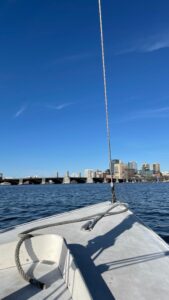
© Nikolai Ratajczak
r of motivation to the professor I wanted to work with in reply to an ad posted in the forum of my scholarship program. Within a week I had talked to two of the present lab members and the professor and was offered a position. This experience highly encouraged me to not be held back by the mystified prestige that has grown around some institutions. As my PI likes to say, in the end “we only cook with water”.
- Accomodation & Living expenses
Life in Boston and Cambridge is full of opportunities. Unfortunately living expenses and housing prices are extraordinarily high. Any room around $1000 a month will be considered cheap. In comparison to housing in Aachen this really requires a change of mind. Luckily, the college structure offers plenty of free food events to learn, participate and get some nice food. Other than that, food prices are two to three times as high as in Germany.
- Everyday life/the internship
I used to be in basic science in Aachen before coming here and was overwhelmed by the different workplace culture: I arrived just before the deadline for one of the conferences the lab attended this year and the work intensity, flow and energy reminded me rather of what I imagine a stock market to be like than what I associate with research. Overall, the team is very supportive and projects are being pushed in a demanding but productive way. Being here is definitely a great learning opportunity and can be a gateway to a career in clinical research. Other than that the city and colleges offer just about anything a student could ask for. I got into sailing and running and joined conferences every now and then.
- Free time/tips

© Nikolai Ratajczak
I really enjoyed my time with the cambridge running club and the community boating incorporation. Also the museums are a must see (MFA, Harvard Arts Museum, MIT Museum, …). Most of them offer free entry at some point or another. Moreover, I love to get out of the city every now and then. Going to New Hampshire, Maine, or Rhode Island for a weekend can offer nice hikes, the experience of a less “European” US and time to bond with new friends.
- Conclusion
I highly recommend anyone to come here. Working with my PI was a great experience.
Writing my master’s thesis in California
- Environmental Engineering M.Sc.
- Berkeley, California, United States of America
- Lawrence Berkeley National Laboratory
- January 2022 – August 2022
My stay abroad at the Lawrence Berkeley National Laboratory (California) was 8 months long, from January 2022 to August 2022. During this time, I was doing research for my master’s thesis (Process Engineering) and did not collect any CPs as a student at UC Berkeley.
Preparations:
I started contacting professors from UC Berkeley, asking for an opportunity to research on my master’s thesis without having a concrete topic. Through several emails and zoom meetings I was invited as a “visiting student researcher” at the Lawrence Berkeley National Laboratory (LBNL), the equivalent to the “Frauenhofer Institut” in Germany. I had to apply for a J1 Exchange Student Visa, which meant filling out many documents and a lot of planning. In total, this process (called Free Mover) took almost a year before I was able to fly to San Francisco International Airport to start my research beginning of January 2022.
Living:
I found a shared apartment via craigslist close to my work and close to the campus. Do not underestimate the costs of living in the Bay area. For my room in a normal sized apartment with three housemates and a garden I paid $950. Food is as well a big expense, for example, a loaf bread costs $9 compared to a German 3€ loaf. Expensive is as well eating out (Pizza $15 compared to 5€) or having drinks (Beer $10 compared to 3€). But the food scene in Berkeley/Oakland/San Francisco is very versatile and vibrant, which surprised me. This all-year-great weather leads to people being active and sociable no matter how expensive life is.
Culture:
Near Berkeley is Oakland, a larger city that has become very attractive to the middle class. In Oakland, you can witness the process of gentrification, which means that the wealthy young generation is taking over an entire neighborhood from the poorer population. Oakland has a vibrant, fascinating culture on one side and crime and poverty on the other. To the west of Berkeley is San Francisco, which can be reached in about 20 minutes by BART, the local subway (cost $5, use ClipperCard). Berkeley is rather a quiet
University town, whereas SF is a magnet for tourists. The best places in SF are the Golden Gate Park (in the center of the city), the Dolores Park (a very crowded park, full of locals), Chinatown and Ocean Beach, there are as well great bars and festivals all year round. North of SF you can go hiking along the coast (Marin County, Point Reyes). In the south is Stanford University with a beautiful campus (Palo Alto). Must-see are as well: Napa Valley and Sonoma County (the wine regions of CA, 1 hour car ride from Berkeley), Lake Tahoe, Yosemite National Park, and Big Sur (each 3 hours car ride from Berkeley).
Daily Life:
Since I was not an official student of the UC Berkeley, I was not able to create a membership for the on-campus gym. Instead, I got a membership at the YMCA gym in Downtown Berkeley, very close to my apartment. I spent the day in the lab working on my research, ate lunch there with colleagues, and then went to the gym. In the evenings, I often took walks to the Rose Garden in Berkeley, hiked around the Fire Trails, watched the sunset at the Berkeley Marina or on top of the Indian Rocks in Berkeley. When spending the weekend in Berkeley, I usually went to: University Ave (Downtown), Southside (the equivalent to the Ponte in Aachen, in South Berkeley), to Temescal (South Berkeley, on the edge to Oakland) and Solano Ave (on the edge to Albany). When I was writing for my thesis, I enjoyed going to the many libraries the campus has to offer (the best being DOE library) and cafes, like Strada, Blue Bottle, Berkeley Espresso and Yali’s. Other things I liked to do: Yoga at Ohlone Park, Sunday food at “Thai Temple” (Wat Mongkolratanaram from 10am-1pm), biking to Lake Temescal.
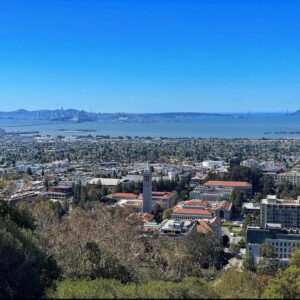
© Emna Aidi
Last Advice:
You will need at least half a year to plan such a research stay abroad. I created a one-page leaflet about my idea to work on my master’s thesis, listing my relevant coursework I took at the RWTH Aachen University and my interests in which I would like to work. I sent it to professors, who seemed to work on similar topics, and kept asking them to help me forward my email to others as well. Apply for scholarships since the research stay will be very expensive (Auslandsbafög, RWTH Research Ambassador, Promos DAAD, GIZ).
View: At the LBNL (located on a hill) overlooking the UC Berkeley campus and San Francisco with the Golden Gate Bridge.

